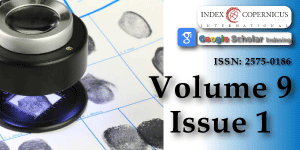Analyzing Maternal Inheritance of Mitochondrial DNA using PCR-RFLP
Main Article Content
Abstract
Background & objectives: Mitochondrial DNA (mtDNA) contains valuable genetic information and plays a crucial role in missing person investigations, mass disasters, and forensic cases involving limited or degraded biological material. mtDNA is maternally inherited, with a highly variable control region divided into three hypervariable regions are generally used for forensic investigation. This study aimed to evaluate maternal inheritance patterns of mtDNA using PCR-RFLP techniques to confirm maternal relatedness.
Method: The study was designed after prior permission from the institute’s ethical committee in which subjects were enrolled. This pilot study analyzed 50 voluntary participants (mother-child pairs). DNA was extracted from blood or saliva, and the mtDNA hypervariable region (HV region) was amplified by PCR using specific primers for the HV1 region. The amplified fragments (1024 bp) were subjected to RFLP analysis using seven restriction endonucleases (Alu I, BsuR I (Hae III), Hinf I, HsYF31 (Dde I), Mbo I, Rsa I, and SsPI) to reveal morphotypes.
Results: The study identified five morphotypes for Alu I, three for BsuR I (Hae III) and Rsa I, two for Hinf I, and one each for HsYF31 (Dde I), Mbo I, and SsPI. There was minimal genetic polymorphism in the hypervariable region among unrelated individuals, but consistent restriction patterns were observed between mothers and their children in same pair.
Conclusion: The findings demonstrate the low genetic polymorphism in the hypervariable region among unrelated individuals and consistent restriction patterns within maternal pairs, underscoring mtDNA's utility in forensic and genealogical applications.
Article Details
Copyright (c) 2025 Sharma N, et al.

This work is licensed under a Creative Commons Attribution 4.0 International License.
Butler JM, Levin BC. Forensic applications of mitochondrial DNA. Trends Biotechnol. 1998;16(4):158–62. Available from: https://doi.org/10.1016/s0167-7799(98)01173-1
Bermisheva MA, Viktorova TV, Khusnutdinova EK. Polymorphism of Human Mitochondrial DNA. Russ J Genet. 2003;39(8):849–59. Available from: https://doi.org/10.1023/A:1025319702808
Marwal A, Sahu AK, Gaur RK. Chapter 16 - Molecular Markers: Tool for Genetic Analysis. In: Verma AS, Singh A, editors. Animal Biotechnology. Academic Press. 2014;289–305. Available from: https://doi.org/10.1016/B978-0-12-416002-6.00016-X
Wallace DC, Brown MD, Lott MT. Mitochondrial DNA variation in human evolution and disease. Gene. 1999;238(1):211–30. Available from: https://doi.org/10.1016/s0378-1119(99)00295-4
Case JT, Wallace DC. Maternal inheritance of mitochondrial DNA polymorphisms in cultured human fibroblasts. Somatic Cell Genet. 1981;7(1):103–8. Available from: https://doi.org/10.1007/BF01544751
Merheb M, Matar R, Hodeify R, Siddiqui SS, Vazhappilly CG, Marton J, et al. Mitochondrial DNA, a Powerful Tool to Decipher Ancient Human Civilization from Domestication to Music, and to Uncover Historical Murder Cases. Cells. 2019;8(5):433. Available from: https://doi.org/10.3390/cells8050433
Sharma S, Saha A, Rai E, Bhat A, Bamezai R. Human mtDNA hypervariable regions, HVR I and II, hint at deep common maternal founder and subsequent maternal gene flow in Indian population groups. J Hum Genet. 2005;50(10):497–506. Available from: https://doi.org/10.1007/s10038-005-0284-2
Salas A, Lareu MV, Carracedo A. Heteroplasmy in mtDNA and the weight of evidence in forensic mtDNA analysis: A case report. Int J Legal Med. 2001;114(3):186–90. Available from: https://doi.org/10.1007/s004140000164
Parson W, Bandelt HJ. Extended guidelines for mtDNA typing of population data in forensic science. Forensic Sci Int Genet. 2007;1(1):13–9. Available from: https://doi.org/10.1016/j.fsigen.2006.11.003
Doosti A, Dehkordi P. Genetic Polymorphisms of Mitochondrial Genome D-loop Region in Bakhtiarian Population by PCR-RFLP. Int J Biol. 2011;3(4):41. Available from: https://doi.org/10.5539/ijb.v3n4p41
Bandelt HJ, Forster P, Sykes BC, Richards MB. Mitochondrial portraits of human populations using median networks. Genetics. 1995;141(2):743–53. Available from: https://doi.org/10.1093/genetics/141.2.743
Richards M, Macaulay V, Hickey E, Vega E, Sykes B, Guida V, et al. Tracing European founder lineages in the Near Eastern mtDNA pool. Am J Hum Genet. 2000;67(5):1251–76. Available from: https://pmc.ncbi.nlm.nih.gov/articles/PMC1288566/
Torroni A, Bandelt HJ, D’Urbano L, Lahermo P, Moral P, Sellitto D, et al. mtDNA analysis reveals a major late Paleolithic population expansion from southwestern to northeastern Europe. Am J Hum Genet. 1998;62(5):1137–52. Available from: https://doi.org/10.1086/301822
Syndercombe Court D. Mitochondrial DNA in forensic use. Emerg Top Life Sci. 2021;5(3):415–26. Available from: https://doi.org/10.1042/ETLS20210204
Butler JM. Advanced Topics in Forensic DNA Typing: Interpretation. Elsevier; 2014. Available from: https://shop.elsevier.com/books/advanced-topics-in-forensic-dna-typing-interpretation/butler/978-0-12-405213-0





